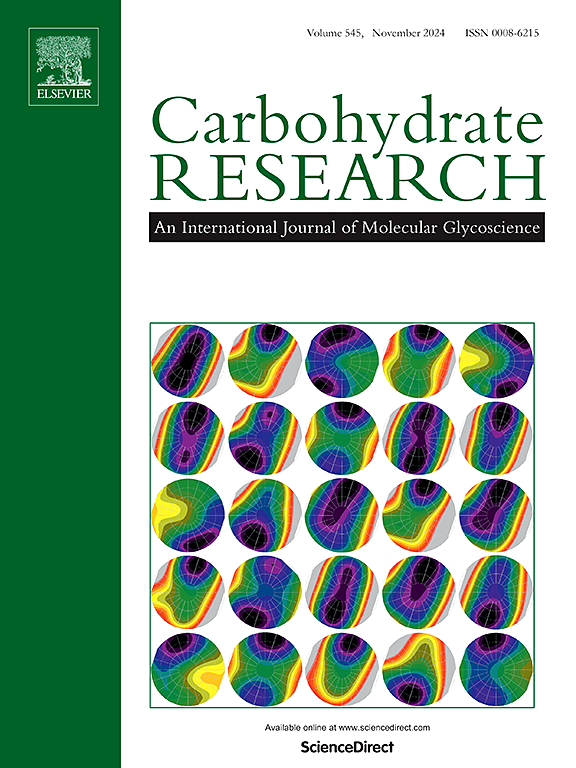硅-多糖荧光纳米复合物在透明细胞肾细胞癌中依维莫司的递送和治疗应用
IF 2.5
3区 化学
Q3 BIOCHEMISTRY & MOLECULAR BIOLOGY
引用次数: 0
摘要
依维莫司在治疗透明细胞肾细胞癌(ccRCC)方面显示出良好的治疗前景,但其生物利用度差,肿瘤靶向性弱,限制了其疗效。在这项研究中,我们利用H4L和bpp配体开发了一个多功能的Co(II)基MOF (CP1),形成了一个3D(4,8)连接的框架。为了提高CP1的稳定性和功能性,我们用海藻酸钠(SA)和APTMS包被CP1,并通过ullmann型偶联进一步用荧光苯并吡喃酮衍生物(化合物1)修饰CP1,得到1-SA-APTMS@CP1。最终得到的纳米载体1-SA-APTMS@CP1@EVE具有较高的比表面积(98.3 m2/g)、介孔(2-6 nm)和较强的结构完整性。双通道荧光检测GSH和NAD(P)H,检测限分别为233pm和65nm。在体外实验中,该系统有效抑制了ccRCC细胞的增殖,下调了关键的免疫调节基因TNFRSF18。这项研究为依维莫司提供了一个氧化还原反应性的、荧光可追踪的给药平台,为ccRCC的靶向和免疫协同治疗提供了潜力。本文章由计算机程序翻译,如有差异,请以英文原文为准。

Silicon-polysaccharide fluorescent nanocomposite for everolimus delivery and theranostic application in clear cell renal cell carcinoma
Everolimus showed therapeutic promise in treating clear cell renal cell carcinoma (ccRCC), yet its efficacy was limited by poor bioavailability and weak tumor targeting. In this study, we developed a multifunctional Co(II)-based MOF (CP1) using H4L and bpp ligands, forming a 3D (4,8)-connected framework. To enhance stability and functionality, CP1 was coated with sodium alginate (SA) and APTMS, and further modified with a fluorescent benzopyranone derivative (compound 1) via Ullmann-type coupling, yielding 1-SA-APTMS@CP1. The final nanocarrier, 1-SA-APTMS@CP1@EVE, exhibited a high surface area (98.3 m2/g), mesoporosity (2–6 nm), and strong structural integrity. It enabled dual-channel fluorescence detection of GSH and NAD(P)H, with detection limits of 233 pM and 65 nM, respectively. In vitro, the system effectively inhibited ccRCC cell proliferation and downregulated TNFRSF18, a key immunomodulatory gene. This study provides a redox-responsive, fluorescence-trackable delivery platform for everolimus, offering potential for targeted and immune-synergistic therapy in ccRCC.
求助全文
通过发布文献求助,成功后即可免费获取论文全文。
去求助
来源期刊

Carbohydrate Research
化学-生化与分子生物学
CiteScore
5.00
自引率
3.20%
发文量
183
审稿时长
3.6 weeks
期刊介绍:
Carbohydrate Research publishes reports of original research in the following areas of carbohydrate science: action of enzymes, analytical chemistry, biochemistry (biosynthesis, degradation, structural and functional biochemistry, conformation, molecular recognition, enzyme mechanisms, carbohydrate-processing enzymes, including glycosidases and glycosyltransferases), chemical synthesis, isolation of natural products, physicochemical studies, reactions and their mechanisms, the study of structures and stereochemistry, and technological aspects.
Papers on polysaccharides should have a "molecular" component; that is a paper on new or modified polysaccharides should include structural information and characterization in addition to the usual studies of rheological properties and the like. A paper on a new, naturally occurring polysaccharide should include structural information, defining monosaccharide components and linkage sequence.
Papers devoted wholly or partly to X-ray crystallographic studies, or to computational aspects (molecular mechanics or molecular orbital calculations, simulations via molecular dynamics), will be considered if they meet certain criteria. For computational papers the requirements are that the methods used be specified in sufficient detail to permit replication of the results, and that the conclusions be shown to have relevance to experimental observations - the authors'' own data or data from the literature. Specific directions for the presentation of X-ray data are given below under Results and "discussion".
 求助内容:
求助内容: 应助结果提醒方式:
应助结果提醒方式:


